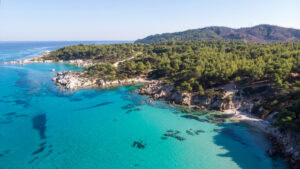A question that is often asked: What is the difference between the north and the south of Cyprus? What truly defines the culture? How is the infrastructure and what are the prices like? Is it difficult to cross to the other side? Here are the most important answers!
The island is divided into two regions – Northern Cyprus (Turkish-controlled) and South Cyprus (Greek-controlled). Both offer distinct travel experiences shaped by their history, culture, and tourism styles. Here’s a quick breakdown:
- Northern Cyprus: Quieter, budget-friendly, uses the Turkish Lira (as well as Euro, US Dollars and GBP), and requires a stopover in Turkey for flights.
- South Cyprus: EU member, well-developed tourism, uses the Euro, and offers direct international flights.
Quick Comparison
| Aspect | South Cyprus | North Cyprus |
|---|---|---|
| Currency | Euro (€) | Turkish Lira (₺), Euro, USD, GBP |
| Airport Access | Direct international flights | Stopover in Turkey required |
| Tourism Style | Developed, mass tourism | Quieter, less commercialized |
| Cost Level | Higher | Lower |
| Language | Greek (English widely spoken) | Turkish (English and Russian widely spoken) |
| Religious Sites | Orthodox Christianity | Sunni Islam |
Both regions offer unique highlights, from South Cyprus’s bustling resorts and ancient Greek influences to North Cyprus’s untouched landscapes and Turkish culture. Whether you’re after luxury or tranquility, Cyprus has something for everyone.
Northern Cyprus Travel Guide (Everything You Need To Know)
Daily Life and Customs
Daily life in Northern and Southern Cyprus showcases distinct cultural characteristics, offering travelers a chance to experience two unique traditions.
Languages and Religious Sites
Language and religion play a key role in defining the cultural identity of each region. In Northern Cyprus, Turkish is the official language, and most people practice Sunni Islam. Meanwhile, in Southern Cyprus, Greek is the official language, with the majority following Orthodox Christianity. English is commonly spoken across both regions, making communication easier for visitors. Both areas uphold religious freedom, allowing for a mix of cultural and spiritual practices. These differences create a rich backdrop for exploration.
Food and Restaurants
Cypriot cuisine brings together a variety of flavors. In Northern Cyprus, the food reflects Eastern Mediterranean influences. Popular dishes include Turkish coffee, which can be served at varying sweetness levels, and desserts like Turkish Delight and baklava. Southern Cyprus leans toward Greek culinary traditions, with standout dishes such as souvla and souvlaki. Across the island, shared favorites like meze, halloumi, and dishes made with fresh, local ingredients celebrate the island’s shared culinary roots.
Local Rules and Behavior
Cultural norms also highlight the differences between the two regions. In Northern Cyprus, hospitality is a cornerstone of daily life, with offering coffee being a common way to welcome guests. Social gatherings like weddings and family events remain deeply important in both parts of the island, showcasing the strong community connections that define Cypriot life.
Travel Requirements and Basics
Visas and Border Rules
Entry protocols vary between Northern and Southern Cyprus. To enter Southern Cyprus, you’ll need to use Larnaca or Paphos airports, or the seaports in Limassol, Larnaca, and Paphos. It’s important to note that the Republic of Cyprus does not consider entry through Northern Cyprus’s Ercan Airport or northern seaports as legal.
In Northern Cyprus, most international travelers can receive a free visa on arrival for stays of up to 90 days. However, visitors from Armenia, Nigeria, and Syria must secure visas in advance through TRNC offices. When crossing between the two regions, a valid passport is required, though EU citizens can use their national ID cards. Be aware that overstaying the 90-day limit without obtaining a residence permit results in a fine of 100.23 Turkish lira per day upon re-entry.
Let’s look at how to navigate transportation in both regions.
Getting Around
Transportation options vary significantly between Northern and Southern Cyprus. In Southern Cyprus, bus fares are €1.50 for a single ride, €5 for a day pass, and €20 for a weekly pass. Taxis charge approximately €3.42 during the day and €4.36 at night. Major international car rental companies operate here, with daily rental costs typically between €25 and €50.
In Northern Cyprus, bus fares are usually between €3 and €4 per ride. Taxi fares, however, are often negotiated rather than metered. With limited public transport options, renting a car is often the easiest way to get around. Speed limits are consistent across both regions: 100 km/h (62 mph) on highways, 80 km/h (50 mph) on main roads, and 50 km/h (31 mph) in urban areas.
Money and Payments
The two regions use different currencies. Southern Cyprus operates with the Euro (€), adopted on January 1, 2008, while Northern Cyprus uses the Turkish Lira (₺). Visa and MasterCard are widely accepted in tourist areas of both regions. For cross-border travel, it’s smart to carry both currencies. Keep cash on hand for smaller businesses or remote areas, and check with your bank about any international transaction fees before your trip.
sbb-itb-c04d957
Places to Stay and Visit
Accommodation Types and Costs
The lodging options and costs in Northern and South Cyprus vary significantly. Northern Cyprus tends to be more budget-friendly, offering boutique hotels, family-run lodgings, and seaside resorts. In contrast, South Cyprus leans toward larger resorts catering to mass tourism. Accommodations in Northern Cyprus are generally 30-50% cheaper, with apartments starting at around €80,000. For example, Caesar Bay offers private apartment rentals for approximately €68 per night. These affordable options make it easier to explore the region’s attractions.
Main Tourist Sites
Both regions are rich in historical landmarks with distinct appeal. South Cyprus is home to the UNESCO-listed Paphos Archaeological Park, featuring Roman villas and intricate mosaics, as well as Petra tou Romiou, also known as Aphrodite’s Rock, tied to ancient mythology. On the other hand, Northern Cyprus showcases the Salamis Ruins, the Selimiye Mosque (formerly the Cathedral of Saint Sophia), and the medieval Saint Hilarion Castle.
Beach and Nature Spots
For outdoor lovers, the two regions offer contrasting experiences. Northern Cyprus is known for its untouched landscapes, including the Karpaz Peninsula, famous for wild donkeys and golden beaches. Activities like hiking, sailing, diving, and golf are popular in its less commercialized setting. Meanwhile, South Cyprus features bustling beach resorts such as Ayia Napa, along with the scenic Troodos Mountains. Northern Cyprus also boasts more forested and unspoiled areas, such as the Kyrenia Mountains and the Karpaz Peninsula. In the south, travelers can enjoy the Akamas Peninsula, alpine trails in the Troodos Mountains, and water sports along the coast of Ayia Napa.
Travel Planning Tips
When to Visit
The best time to visit Northern Cyprus depends on your weather preferences and how much you want to avoid crowds. With over 300 sunny days a year, it’s a great destination for outdoor activities. For pleasant temperatures and fewer tourists, aim for May, June, September, or October.
- May: Expect highs around 82°F (28°C), perfect for both sightseeing and relaxing on the beach.
- July: Temperatures can soar to 100°F (38°C), making early mornings and evenings the best times for outdoor activities.
- October: Cooler at 79°F (26°C), great for cultural tours and outdoor adventures.
- November–March: Daytime highs range from 57°F to 61°F (14°C–16°C), ideal for exploring historical sites without the crowds.
Keep in mind that safety protocols and connectivity can differ depending on where you are on the island.
Safety Guidelines
Cyprus is generally safe for tourists, but there are a few things to keep in mind, especially in Northern Cyprus. The U.S. Embassy in Nicosia has limited ability to assist American citizens in the northern region.
- Entry Points: Always enter Cyprus through officially recognized ports in the south.
- Photography: Avoid taking photos of military areas in both regions.
- Travel Insurance: Make sure your insurance covers both parts of the island.
- Driving: Be cautious on the roads, as safety standards are lower in some areas.
"Exercise a high degree of caution in northern Cyprus. Canada does not recognize the so-called ‘Turkish Republic of Northern Cyprus’." – Government of Canada
Staying safe is important, but staying connected is also key.
Phone and Internet
In South Cyprus, using your phone is straightforward, with minimal extra charges. Northern Cyprus, however, runs on a different network and uses the Turkish area code (+90).
Here’s how to stay connected:
- South Cyprus: Prepaid SIM cards cost about €15 ($16.25) and usually include airtime and texts.
- Northern Cyprus: eSIM options like BLINK are a good choice for internet access.
- Texting: Text messaging between the North and South isn’t available.
Internet is widely accessible through ADSL broadband and wireless connections, and many cafés offer free Wi-Fi. Just remember, using your phone while driving is illegal everywhere in Cyprus.
Conclusion
Key Takeaways
Northern Cyprus is a more budget-friendly destination with lower costs for accommodation and dining, while South Cyprus offers the convenience of direct international flights through Larnaca and Paphos airports.
Here’s a side-by-side look at some important travel factors:
| Aspect | South Cyprus | North Cyprus |
|---|---|---|
| Currency | Euro | Turkish Lira |
| Airport Access | Direct international flights | Requires a layover in Turkey |
| Tourism Style | Developed, mass tourism | Quieter, less commercialized |
| Cost Level | Higher | Lower |
| Cultural Influence | Greek Orthodox | Turkish and Islamic |
These differences showcase the unique appeal of each region.
Deciding Which Side to Visit
Pick South Cyprus if you’re looking for:
- Well-established tourism services
- Direct international flight options
- Experiences rooted in Greek culture
- Access to European-style amenities
Opt for North Cyprus if you prefer:
- Budget-friendly travel options
- Peaceful, less crowded attractions
- A deep dive into Turkish culture
- Untouched natural beauty
"Foreign nationals who have entered Cyprus through the north are considered by the Government of the Republic of Cyprus to have arrived through an illegal port of entry."

